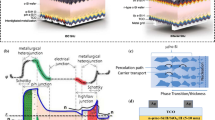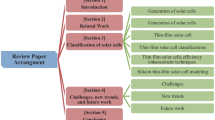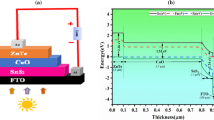Abstract
High efficiency multicrystalline solar cells must improve performance while replacing higher cost monocrystalline silicon with lower cost multicrystalline silicon. Composite silicon dioxide-titanium dioxide (SiO2−TiO2) films are deposited on a large area of 15.6×15.6 cm2 textured multicrystalline silicon solar cells to increase the incident light trapped within the device. This is being achieved through new cell device structures that improve light trapping and energy conversion capability. These new structures depend on passivated thick and thin layers of silicon dioxide and titanum dioxide grown via wet and dry thermal oxidation. By replacing dry oxidation with wet oxidation the temperatures process can be lowered from 1050∘C to 850∘C to reduce both cycle time and wafer damage.
Similar content being viewed by others
References
Hongchen M, Lang Z (2013) Mechanical behavior of diamond-sawn multi-crystalline silicon wafers and its improvement. Silicon 6:129–135
Morito H, Karahashi T, Uchikoshi M, Isshiki M, Yamane H (2012) Low-temperature purification of silicon by dissolution and solution growth in sodium solvent. Silicon 4:121–125
Wu JJ, Ma WH, Yang B, Liu DC, Dai YN (2012) Calculation and characterization of silicon-boron phases in metallurgical grade silicon. Silicon 4:289–295
Xiao C, Yang D, Yu X, Xiang L, Que D (2014) Determination of the boron and phosphorus ionization energies in compensated silicon by temperature-dependent Luminescence. Silicon
Watanabe N, Kondo Y, Ide D, Matsuki T, Takato H, Sakata I (2010) Characterization of polycrystalline silicon wafers for solar cells sliced with novel fixed-abrasive wire. Progress in Photovolt Res Appl 18(7):485–490
Yeung B, Lee TY (2003) An overview of experimental methodologies and their applications for die strength measurement. IEEE Trans Components Packag Technol 26(2):423–428
Hopcroft MA, Nix WD, Kenny TW (2010) What is the Young’s modulus of silicon? J Microelectromech Syst 19(2):229–238
Hu SM (1982) Critical stress in silicon brittle fracture, and effect of ion implantation and other surface treatments. J Appl Phys 53(5):3576–3580
Swalin RA (1962) Thermodynamics of solids. Wiley, New York, pp 144–146
Lawn BR, Hockey BJ, Wiederhorn SM (1980) Atomically sharp cracks in brittle solids: an electron microscopy study. J Mater Sci 15:1207–1223
Schiøtz J, Carlsson AE, Canel LM, Thomson R (1996) Effect of crack blunting on subsequent crack propagation. Mat Res Soc Symp Proc 409:95–100
Bidiville A, Wasmer K, Kraft R, Ballif C (2009) Diamond wire-sawn silicon wafers from the lab to the cell production. In: 24th European photovolatic solar energy conference and exhibition, pp 1400–1405
Bidiville A, Heiber J, Wasmer K, Habegger S, Assi F (2010) Diamond wire wafering: wafer morphology in comparison to slurry sawn wafers. In: 25th European photovoltaic solar energy conference and exhibition/5th world conference on photovoltaic energy conversion, Valencia, pp 1673–1676
Green MA (2003) Third generation photovoltaics: advanced solar electricity generation, vol 12. Springer, Berlin Heidelberg. 978-3-540-26562-7 (Print) 978-3-540-26563-4 (Online)
Zhao J, Wang A, Green MA (1999) 24.5 % efficiency silicon PERT cells on MCZ substrates and 24.7 % efficiency PERL cells on FZ substrates. Prog Photovolt 7:471–474
Coniber G (2007) Third-generation photovoltaics. Materials Today 10:42–50
Cho E-C, Green MA, Conibeer G (2007) Quantum dots in a dielectric matrix for all-silicon tandem solar cells. In: Advances in opto electronics. Hindwai Publishing Corporation, pp 1–11
Green MA, Conibeer G, Koning D, Cho EC, Song D, Cho Y, Fangsuwannarak T, Huang Y, Scardera G, Pink E, Huang S, Jiang C, Trupke T, Corkish R, Puzzer T (2006) Progress with all-silicon tandem cells based on silicon quantum dots in a dielectric matrix. In: Proceedings of the 21st European photovoltaic solar energy conference, Dresden, pp 10–14
Author information
Authors and Affiliations
Corresponding author
Additional information
A. A. El-Amin holds a degree of PhD at Taibah University
Rights and permissions
About this article
Cite this article
El-Amin, A.A., Zaki, A.A. Improving the Efficiency of Multicrystalline Silicon by Adding an ARC Layer in the Front Device. Silicon 9, 53–58 (2017). https://doi.org/10.1007/s12633-015-9290-y
Received:
Accepted:
Published:
Issue Date:
DOI: https://doi.org/10.1007/s12633-015-9290-y




